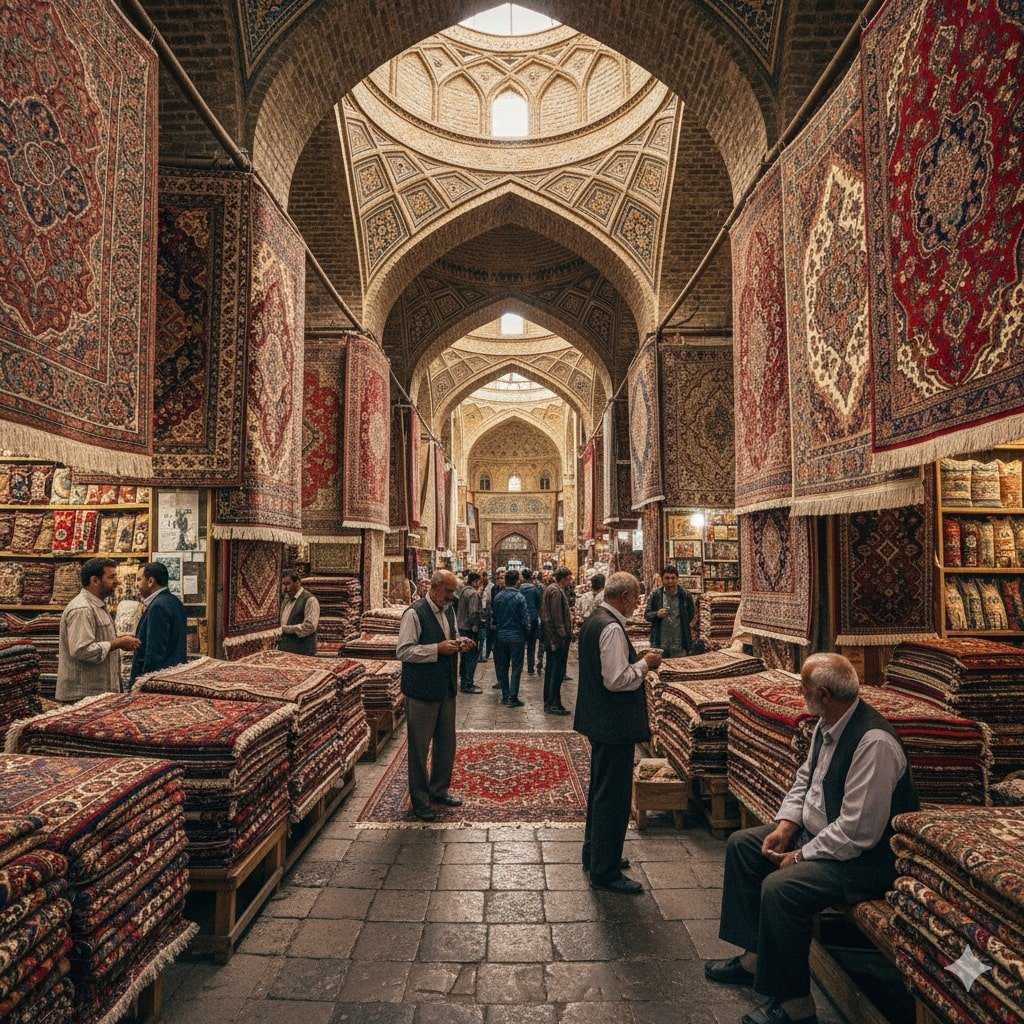Persian Rug Market: The Rug Market in Iran
- By Mehdi Sharafi
- Last updated: October 17, 2025

Iran’s centuries-old “Persian rug” brand still commands the global imagination, but exports and trade flows have shifted dramatically in the last decade. Sanctions, payment/shipping difficulties and falling tourism have reduced Iranian exports to a fraction of their earlier scale; at the same time, global demand for authentic, high-quality Persian pieces remains strong and auction prices for fine and antique rugs continue to attract buyers worldwide.
In this article, we learn about the current market, price ranges in Iran vs overseas, legal considerations for buyers, how to authenticate rugs, and where to go for wholesale purchases.
Current state of the Persian Rug Market (2024 – 2025)
Two big facts shape the market today:
- A collapse in exports from Iran: Official and independent reporting shows Iranian hand-woven carpet exports dropped from the hundreds of millions (and over $2 billion historically two decades ago) to under ~$50 million in the Persian calendar year that ended in March 2024, a fall driven largely by sanctions, payment and shipping difficulties and a collapse in tourism. This has forced many Iranian workshops to close or reduce production.
- Narrow signs of recovery and global demand for authenticity: Some 2025 reporting shows modest rebounds in production or exports in certain months and renewed interest in authentic Persian craftsmanship. However, the export base remains far below earlier levels and recovery, if it continues, will likely be gradual and uneven. (In short: demand exists; supply from Iran is constrained.)
However, it must be said that the missteps of some Iranian producers have also significantly contributed to the sector’s decline. The 1980s, for instance, saw a rapidly growing market buoyed up by the fashionable appeal to Western customers for Gabbeh rugs woven by nomadic tribes. The boom attracted many fly-by-night producers to the sector. Who, in a tragically comic turn of events, used production techniques of their worst international competitors to churn out cheap stock.
Albeit in those years, we at Sharafi & Co. and a significant number of established merchants also traded in the “Gabbeh Boom”. But we all sought out authentic goods.
Meanwhile, the global carpets & rugs market remains large and growing: market research places the global market value in the tens of billions of USD (estimates vary by report) and projects steady growth over the coming decade, which means demand for authentic and well-made rugs remains strong even as manufacturing shifts to other countries.
Takeaway: The “Persian” brand (historically associated with Iran) still carries high value, but the international supply picture is fragmented: many Persian-style rugs are now woven in Turkey, India, Pakistan, and elsewhere. For buyers and sellers this means authenticity matters more than ever.
2) Price guide: How much do Persian rugs cost in Iran?
Prices vary dramatically by origin (city/village), size, material, knot density (fineness) and condition (new, vintage, antique). Below are typical buyer ranges based on recent buyer guides and market reports — use as a starting point, not a guarantee.
| Category | Typical Iran price (approx.) | Notes |
|---|---|---|
| Small machine-made runner / mat | $30 – $150 | Lower quality, mass-produced |
| Small handmade village/tribal (e.g., Gabbeh, small Qashqai) | $150 – $800 | Good value if handwoven; great for everyday use |
| Medium handmade village/city wool | $400 – $3,000 | Quality, knot density, natural dyes increase price |
| Large fine wool or part-silk city rug | $1,500 – $15,000+ | Fine knotwork, silk highlights or famous workshop provenance push prices high |
| Antique or very high-end silk rugs | $5,000 – $100,000+ | Auction prices can be much higher for rare pieces; provenance and condition crucial |
Important cost factors for buyers: shipping, insurance, customs/taxes, verification/appraisal fees, and any compliance costs for payment to Iranian entities (see embargo section). When shipping internationally, import duties and VAT often make the landed cost in Europe/US much closer to or above local retail prices.
Persian rug embargo & sanctions
There is no global ban on buying Persian rugs, but international sanctions on Iran complicate payments, banking and sometimes shipping. Practical points:
- Legal & payment risk: Sanctions and financial restrictions imposed by the United States and other jurisdictions on Iran affect the ease of paying Iranian sellers and transferring funds. Buyers should consult official guidance (for example, OFAC/US Treasury) and local customs authorities before attempting to import directly.
- Shipping & customs: Some carriers or insurers will not transport goods from Iran, or will do so only with extra compliance checks; customs treatment varies by country.
- Workaround options: Many buyers work through reputable international dealers, auction houses (which handle provenance and compliance), or buy vintage/antique pieces already located outside Iran to avoid direct import complications.
Bottom line: If you plan to buy directly from Iran, get legal/payment advice and confirm shipping and customs ahead of purchase. When in doubt, work with an established dealer who handles compliance.
How to authenticate & value a Persian rug
If you have (or are shopping for) a rug and want to know whether it’s a genuine Persian piece and how it might be valued, use this checklist:
Quick visual checks (non-expert)
- Look at the back: hand-knotted rugs show individual knots on the reverse and a somewhat uneven knot pattern; machine-made rugs have uniform backing and often rows of machine stitching.
- Check knot density (KPSI): more knots per square inch = more detail and typically a higher value. Use a ruler to count knots across 1 inch horizontally and vertically and multiply.
- Examine fibres & sheen: natural wool and silk have a distinct luster and handle; synthetic fibres look and feel different.
- Look for natural dyes: vegetable dyes fade and age differently from synthetic dyes; unevenness in shade can be a sign of natural dyeing.
- Design & motifs: some motifs and layouts are characteristic of regions (e.g., Heriz geometric medallion vs. Isfahan floral). See the regional guide below.
Provenance & paperwork
- Ask for provenance: labels, receipts, workshop or merchant documentation, photos of the weaver or workshop add credibility.
- Look for repairs & restoration: expert repairs can preserve value; amateur repairs may reduce it.
- When in doubt, get a professional appraisal: for any rug you believe to be worth over a few thousand dollars, use an auction house, accredited appraiser, or specialist dealer. Auction houses often publish comparable sale prices.
Regional guide: what each Persian centre is known for
A short primer to help match names to expected design & quality:
- Tabriz: city rugs with fine knotting and often complex medallions; durable and frequently in the mid–high price range.
- Isfahan: fine city rugs, often silk or high-quality wool with floral motifs and high knot density. Highly valued.
- Kashan: classic designs, strong tradition of silk and wool rugs; fine finishing.
- Heriz & Serapi: robust, geometric patterns, very durable (popular for larger floor coverings).
- Bidjar: famed for durability and heavy construction; highly prized for longevity.
- Qashqai, Bakhtiari, Kurdish: tribal and village rugs — strong patterns, vibrant but sometimes coarser knotting; excellent value and character.
- Gabbeh (Bakhtiari/Qashqai): simple, bold tribal carpets often woven by nomadic groups; popular in Western markets for “modern rustic” interiors.
(Each name can clue you into weave, materials and typical price band — always ask which city/tribe and request photographs of the weave and back.)
6) Wholesale, buying from Iran and practical steps
If you’re a wholesaler or buyer looking for volume:
- Minimum orders & lead times: Iranian workshops that export typically require MOQ and long lead times (months), though these vary widely. When export infrastructure is weak, timelines lengthen.
- Verify the seller: ask for company registration, export documentation, and references. Use escrow or an intermediary when possible.
- Quality control: arrange third-party inspection pre-shipment to verify knot count, pile, dyes and packing.
- Payment & compliance: confirm you can legally pay the seller; banks and payment processors may block transfers to Iranian accounts depending on your country.
Alternative for wholesalers: source pre-existing Iranian stock through international dealers or auction houses (this avoids some export complications). Auction houses and specialised dealers also provide certificates of authenticity and provenance.
Frequently Asked Questions
Are Persian rugs cheaper in Iran?
Often, they are cheaper at source because local prices reflect local labour and removed middleman margins. However, when you include shipping, customs, insurance and potential compliance costs, the landed price can narrow considerably. Always compare the full landed cost.
What is the Persian rug embargo?
There is no universal “rug embargo,” but international sanctions on Iran affect payments and trade in many categories; consult official sanctions guidance (e.g., OFAC) before importing directly.
How do I know if my rug is a genuine Persian rug?
Check knotting, weave back, knot density, fibre type and dyes; for valuable pieces seek a professional appraisal. See the checklist above.
Conclusion
Vintage and antique Persian rugs remain in demand in Western markets and continue to realise record auction prices. In turn, producers who stay in the sector strive to produce and sell the best our designers and master weavers can conjure up.
Iranian production may not go up to the levels of the 80s and 90s. But by producing quality goods, they will take back some of the market share they lost once the embargo is lifted, and we will see a steady price rise. Quality remains the key for those who continue to trade in the sector. This is where the centuries-old industry is unbeatable.
Ultimately, regarding the global brand, the “Persian Rug”, Iran owns the market, while all others pay rent. Yet this global brand is not protected like other international brands. For example, in 1891, the Treaty of Madrid established that only wine produced in the Champagne appellation could bear the name. This was reiterated in the Treaty of Versailles after World War I, and the region then obtained official AOC recognition (appellation d’origine controlee) in 1936.

